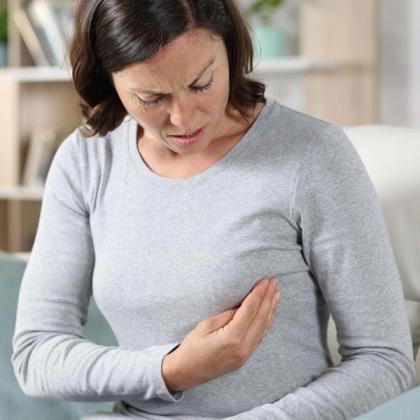Breast pain affects around 70% of women at some point in their lives and is a common reason for referral to breast clinics. It is often a cause of anxiety for women who may be concerned that their pain might be associated with breast cancer. In this episode, Dr Kate Chesterman discusses the assessment of the patient presenting with breast pain and explains the lack of association between breast cancer and breast pain in those with a normal clinical examination. She considers cyclical, non-cyclical and extra-mammary pain and discusses the causes and management options for these, as well as considering when referral to secondary care would be appropriate.
Key references
- NHS. 2023. https://www.nhs.uk/conditions/breast-pain/.
- Northern Cancer Alliance. https://northerncanceralliance.nhs.uk/primary-care/breast/.
- Surrey and Sussex Cancer Alliance. https://surreyandsussexcanceralliance.nhs.uk/health-professionals/primary-care/breast-pain-guidance-and-resources.
- Hubbard TE, et ll. Br J Gen Pract. 2020;70(697):419-420. doi:10.3399/bjgp20X712133.
- Royal United Hospitals Bath NHS Foundation Trust. https://www.ruh.nhs.uk/patients/patient_information/BRU016_GLA_For_Breast_Pain.pdf.
- Jahan M, et al. BMJ Open Qual. 2022;11:e001634. doi:10.1136/bmjoq-2021-001634.
- Breast Cancer Now. https://breastcancernow.org/sites/default/files/files/breast_pain_chart.pdf.
- Coppafeel. https://coppafeel.org.
- Breast Cancer Now. 2017. https://breastcancernow.org/sites/default/files/publications/pdf/bcc71_-_breast_pain_-_web_pdf.pdf.
- Association of Breast Surgeons. 2024. https://associationofbreastsurgery.org.uk/media/qvhdb0p2/breast-pain-statement-final-february-2024.pdf.
Key take-home points
- Breast pain affects around 70% of women at some point in their lives and can account for up to 41% of referrals to breast one-stop triple-assessment clinics.
- Cyclical breast pain is thought to be related to hormonal changes in the menstrual cycle. It occurs in the luteal phase and builds until menstruation begins. It is usually alleviated by the onset of menses.
- Non-cyclical breast pain does not change with a patient’s menstrual cycle. It can occur due to pregnancy or prescribed hormonal medication. It can also occur secondary to breast conditions such as fibrocystic disease, trauma, previous breast surgery, malignancy, and inflammatory conditions such as mastitis or breast abscesses.
- Extra-mammary pain is pain occurring from structures outside of the breast. Causes can be musculoskeletal in origin, as well as conditions such as fibromyalgia, herpes zoster infection, or referred pain due to ischaemic heart disease, gallstones or gastro-oesophageal reflux.
- If it is not clear whether there is a cyclical pattern, asking the patient to complete a breast pain diary for at least two cycles can be very informative.
- An examination should focus on looking for features of breast cancer, as well as for inflammatory findings that may indicate infection.
- In the absence of any concerning clinical findings, breast pain alone is not indicative of breast cancer.
- Well-fitted underwear is recommended to be worn 24 hours a day with soft support at night and increased support during exercise.
- Topical non-steroidal anti-inflammatory drugs are generally recommended as first-line management and can be used for 3 months. Oral paracetamol is also frequently recommended and should be taken four times a day for 2 weeks and extended for a further 2 weeks if it is helping.
- There is very limited evidence for dietary changes or supplements such as flaxseed, vitamin B6, vitamin E or reducing caffeine.
- There is also a lack of proven efficacy for switching oral contraceptives or selective serotonin reuptake inhibitors or for the use of diuretics or tibolone.
- Due to a lack of evidence, evening primrose oil is also not recommended but due to being low risk, and reports of benefits in some women, it does still appear in some local guidelines.
- A referral would be appropriate for pain that is not resolving with conservative management and that is impacting quality of life or sleep.
Create an account to add page annotations
Add information to this page that would be handy to have on hand during a consultation, such as a web address or phone number. This information will always be displayed when you visit this page
